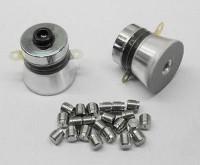I've had a chance to look over Supeno's paper Sonochemical Fixation of Nitrogen in detail.
Quickly summarizing his results: Ammonia and various nitrate compounds (depending on supplied gases) are formed when the gases are bubbled up through water and sonicated. The rate of formation is very low, in the neighborhood of nanomoles per minute per watt, depending on reaction and conditions.
Other papers report similar rates of formation, with results ranging from tenths of nanomoles to micromoles per minute per watt (pages 9-11 in the referenced paper).
This is actually good news. If no researcher had seen formation of nitrates or ammonia in sonication experiments, this would mean that some fundamental principle invalidates the model. Since some formation was seen, then the model is correct at some level.
Additionally, the wide range of results (nanomoles to micromoles per watt) indicates that the model is dependent on experimental conditions, and this opens the possibility that the model could be explored in creative ways.
That said, a hobbyist-grade sonicator in the 50-100 watt range is an interesting project in it's own right, so I'm still intending to build one of those, and publish the designs.
======
Ultrasonic transducers (normally used in cleaning baths) with power output up to about 120 watts are common on eBay, at a cost of about $20 - $50 depending on vendor and power. That's about right for a hobbyist unit, it's easily available, and shouldn't require extreme electronics for the driver (I think).

So I'm thinking: one of these transducers inside an H-bridge driver, a two hundred volt DC power supply, a microcontroller to generate frequency and control power, and a machined horn to transfer energy to the reaction chamber.
A small sonicator could be used for other hobbyist purposes such as plastic welding, cleaning, (possibly) spot welding, cell disruption, drilling, and probably a bunch of other things I'm not thinking of.
So even without the Nitrogen aspect, it's still an interesting project. To me, at least.
 Peter Walsh
Peter Walsh
Discussions
Become a Hackaday.io Member
Create an account to leave a comment. Already have an account? Log In.